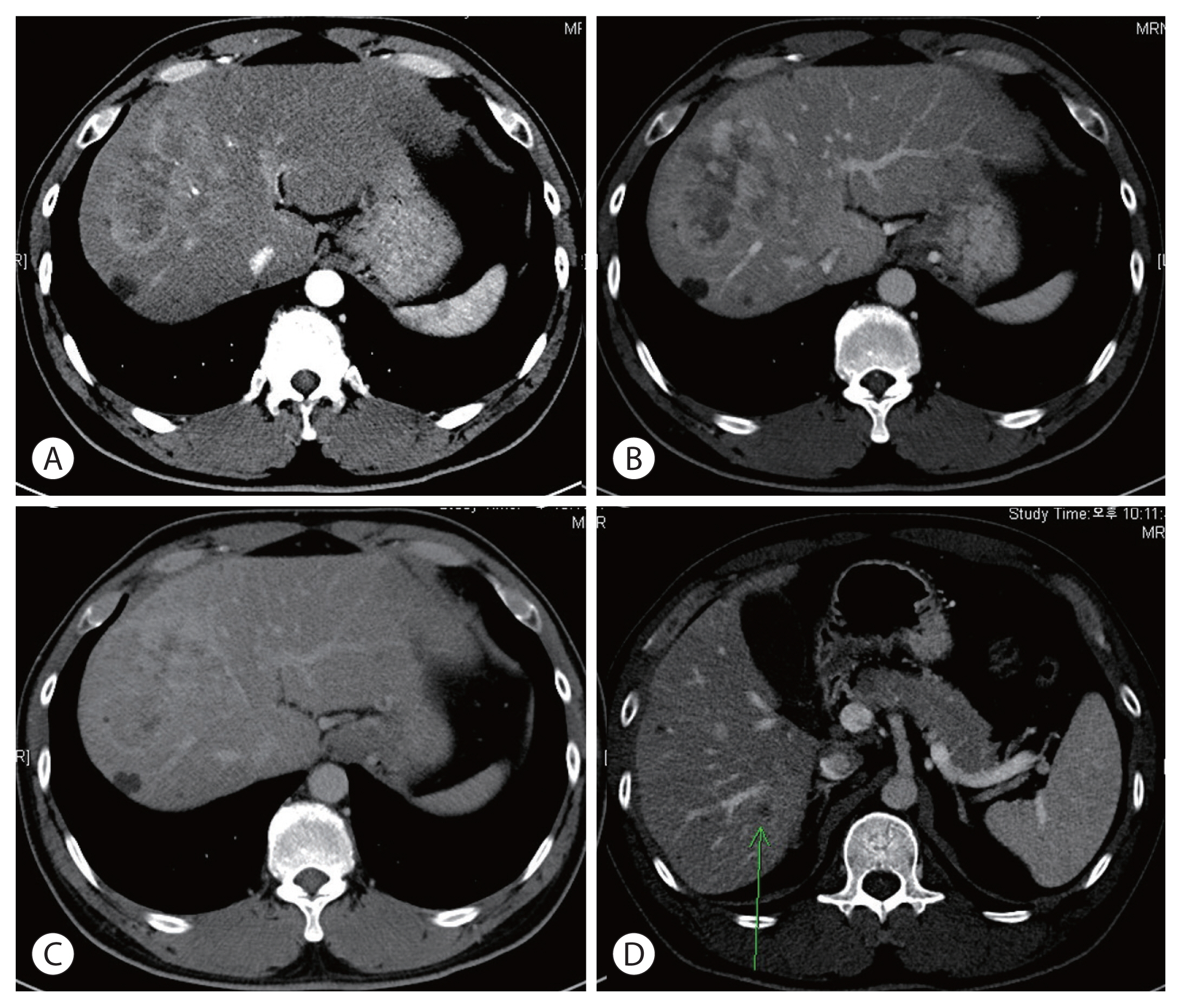Search
- Page Path
- HOME > Search
Case Reports
- Long-term survival after CCRT and HAIC followed by ALPPS for hepatocellular carcinoma with portal vein invasion: a case report
- In-Jung Kim, Sung Hwan Yoo, Jung Il Lee, Kwan Sik Lee, Hyun Woong Lee, Jin Hong Lim
- J Liver Cancer. 2022;22(1):84-90. Published online March 22, 2022
- DOI: https://doi.org/10.17998/jlc.2022.03.07

- 2,789 Views
- 70 Downloads
- 1 Citation
-
 Abstract
Abstract
 PDF
PDF - There are various methods for treating advanced hepatocellular carcinoma with portal vein invasion, such as systemic chemotherapy, transarterial chemoembolization, transarterial radioembolization, and concurrent chemoradiotherapy. These methods have similar clinical efficacy but are designed with a palliative aim. Herein, we report a case that experienced complete remission through “associating liver partition and portal vein ligation for staged hepatectomy (ALPPS)” after concurrent chemoradiotherapy and hepatic artery infusion chemotherapy. In this patient, concurrent chemoradiotherapy and hepatic artery infusion chemotherapy induced substantial tumor shrinkage, and hypertrophy of the nontumor liver was sufficiently induced by portal vein ligation (stage 1 surgery) followed by curative resection (stage 2 surgery). Using this approach, long-term survival with no evidence of recurrence was achieved at 16 months. Therefore, the optimal use of ALPPS requires sufficient consideration in cases of significant hepatocellular carcinoma shrinkage for curative purposes.
-
Citations
Citations to this article as recorded by- Is multidisciplinary treatment effective for hepatocellular carcinoma with portal vein tumor thrombus?
Won Hyeok Choe
Journal of Liver Cancer.2022; 22(1): 1. CrossRef
- Is multidisciplinary treatment effective for hepatocellular carcinoma with portal vein tumor thrombus?

- Bronchobiliary Fistula after Transarterial Chemoembolization and Radiotherapyfor Hepatocellular Carcinoma with Bile Duct Invasion
- Jungran Choi, Yoomi Park, Kwangwon Rhee, Daewon Ma, Ja Kyung Kim, Jung Il Lee, Kwan Sik Lee, Kwang-Hun Lee, Seokjin Haam
- Journal of the Korean Liver Cancer Study Group. 2013;13(2):173-177. Published online September 30, 2013
- DOI: https://doi.org/10.17998/jlc.13.2.173
- 898 Views
- 2 Downloads
-
 Abstract
Abstract
 PDF
PDF - Trans-arterial chemoembolization (TACE) is widely used in the treatment of unresectable hepatocellular carcinoma (HCC). Its common complications are right upper quadrant pain, nausea, vomiting, whereas some rare complications include focal pancreatic necrosis, gastric ulcer, renal failure, DIC, biliary tree necrosis and splenic infarction. Bronchobiliary fistula (BBF) is a rare complication that consists of the formation of a passageway between the biliary system and the bronchial tree. We report a case of BBF due to previous TACE for HCC.

- A Case of Emergent Treatment for Hemodynamic Unstable Patient with Ruptured Hepatocellular Carcinoma
- Jae Keun Kim, Joon Seong Park, Ja Kyung Kim, Hyo Jun Lee, Kwang Hoon Lee, Kwan Sik Lee, Dong Sup Yoon
- Journal of the Korean Liver Cancer Study Group. 2012;12(2):160-163. Published online September 30, 2012
- 498 Views
- 1 Download
-
 Abstract
Abstract
 PDF
PDF - A ruptured Hepatocellular carcinoma (HCC) is one of life threatening complication and considered as poor prognosis. Hemodynamic stability is a key to the early period survival. Hemostasis can be achieved with transarterial embolization and explo‐laparotomy or surgical resection. Prognosis is related to hemodynamic stability and liver function and tumor size. Surgical resection of ruptured HCC is recommended when it is possible. Further studies are needed for the treatment of recurred and progressive patients with ruptured HCC.


 E-submission
E-submission THE KOREAN LIVER CANCER ASSOCIATION
THE KOREAN LIVER CANCER ASSOCIATION

 First
First Prev
Prev



 Follow JLC on Twitter
Follow JLC on Twitter